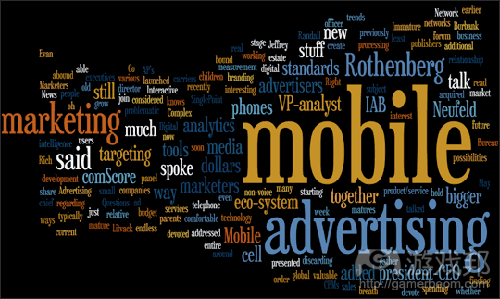阐述营销人员对手机广告的3个误解
作者:David Bussin
关于手机广告的质量和成功的谈话一直持续着。并且很快地发展成为有关手机广告乏善可陈性能的根源的讨论。
是潜在的恐慌和防御性定义了这一谈话,即受到较高的期望与逐渐衰弱的耐性的冲突所驱使。何时手机广告才能到达其所承诺的最大潜能?基于快速改变的技术以及用户使用方法,它们是否真的能够做到这点?
手机广告预测上方的“乌云”并不是广告所依赖的快速发展的技术所造成的,也不是消费者不可预测行为的错。这是市场营销者不能有效地做出解释所引起的。
手机设备能够处理无数的任务,它们也正在将全新屏幕带向新的领域和环境。用户追踪和广告传达正在不断完善着。尽管移动领域前途光明,市场营销者还是难以将新技术引进手机广告中,更重要的是,他们无法将移动平台作为营销活动的一个整合环节。
手机不仅仅是关于直接反应
引起挫败的一大原因便是过于专注于衡量手机活动的直接反应(DR)成功。市场营销者总是会只专注于DR的测量,而只围绕着手机的唯一一种价值运行活动。当然了,这样的性能潜能很高,但是最有效的手机活动还是跨平台和品牌意识。
当市场营销者将自己限制在只有DR的手机策略中时,他们便会忘记其它用户体验也很重要,即使这些内容更加难以测量。手机设备是用户许多亲密时刻的栖息地,这里还存在许多未开发的潜能。而这里所存在的挑战是找到用户粘性和行动号召的有效组合。
手机不仅仅是关于技术
市场营销者所面临的另一大难题便是技术的快速变化的本质。有些人会有这样的坏习惯,即盲目地扑向任何新出现的技术。我们便看过许多目光短浅的人在尝试QR代码广告,糟糕的手机横幅广告以及其它笨拙的理念。尽管占据领先优势非常重要,并且这也会推动市场营销的创新,但是胡乱尝试任何新技术将会导致你创造出一款糟糕的游戏。当然了,如果执行只不过是一种实验的话,那么结果便是不可预知的。
手机不仅仅是一种跨渠道体验
技术的改变会阻碍我们对于用户的使用方法的预测:就像一些使用新技术(游戏邦注:如NFC,区域限定和签到等)的糟糕活动执行。人们会基于各种情况和各种方法去使用自己的设备。手机市场营销最好能够成为更大的跨渠道活动中的一大组成部分。
在过去几年,星巴克便管理着一个精心整合的跨渠道项目。拥有许多国外品牌的资源,同时还对用户有着深刻的了解,星巴克创造出了属于自己的封闭式市场营销环境。他们一直在追踪手机商店内部付费情况,监视并奖励消费者的忠诚度,甚至还跨越无数个平台去提供广告服务。星巴克的成功是可预测的,并且他们的目标,创造性和执行都是无可挑剔的优秀,所以他们的服务才会变成一种品牌体验。
手机广告并不是存在于一个奇幻的媒介中,它也同样拥有市场营销者困扰了十几年的问题。面对无数传达广告的新方法的出现,我们需要做的仍然是创造出吸引人的广告,即作为跨渠道活动和体验的一大组成部分。市场营销者必须足够开放且具有实验精神,敢于冒险并创造全新的成功指标。在你的团体中创造一种新型的冠军将推动更好的手机广告时代的到来。
(本文为游戏邦/gamerboom.com编译,拒绝任何不保留版权的转载,如需转载请联系:游戏邦)
What’s wrong with mobile ads?
By David Bussin
There’s an ongoing conversation about the quality and success of mobile advertising that has struck nerve with a lot of people. It’s quickly devolved into an argument about for the root cause of mobile advertising’s lackluster performance.
A layer of underlying panic and defensiveness defines the conversation, driven by the clash of lofty expectations and waning patience. When will mobile ads reach their promised potential? Can they ever, relying on technologies that change as fast as the way consumers use them?
Any storm clouds in mobile advertising’s forecast aren’t the fault of the constantly evolving technology the ads are served on, or the unpredictable behavior of consumers being handed that technology at an overwhelming pace. They’re the fault of marketers failing to effectively account for either.
Mobile devices can handle a seemingly limitless number of tasks, and they’re bringing new screens into new places and contexts. And tracking users and delivering ads is only going to improve. But despite the promise of mobile, marketers consistently struggle with implementing new technologies into mobile campaigns, and more importantly, struggle with making mobile a cohesive part of the marketing mix.
Mobile is more than direct response
One of the largest causes of frustration is an overly intense focus on measuring the direct response (DR) success of a mobile campaign. Marketers too often default to measuring only DR and inevitably run campaigns around the assumption that it is mobile’s one and only value. Of course, the performance potential is high, but the most effective mobile campaigns are cross-platform and branding conscious.
When marketers allow themselves to be confined to DR-only mobile strategies they can forget that other user experiences are important, even if more difficult to measure. Mobile devices are home to some of our most intimate moments and there’s a huge amount of untapped branding potential there. The challenge is in finding the right mix of engagement and call to action.
Mobile is about more than just the tech
Another crux for marketers has been the fickle and fast-changing nature of the technology that makes delivering mobile ads possible in the first place. Some of us have the bad habit of jumping on any new technology that arises. We’ve all seen short-sighted and messy attempts at QR code ads, bad mobile banner ads, and other awkwardly executed ideas. Being on the leading edge is important, and it drives a lot of the innovation in marketing, but haphazardly trying to implement any and all new technology has given mobile a bad name. Of course results seem unpredictable and disappointing when the execution is nothing more than an experiment.
Mobile’s about the cross-channel experience
Hand-in-hand with the curveballs thrown by changing technology has been frustration with predicting if and how consumers will use it: just look at the poor execution of campaigns using new technologies – like NFC, geo-fencing and check-ins. People are using their devices in nearly every situation, and in incredibly nuanced ways. Mobile marketing should be equally as nuanced, as a part of larger cross-channel campaigns.
For the past few years, Starbucks has led the charge with the ultimate – and oft-cited – example of a carefully integrated cross-channel program. Working with resources foreign to most brands, but also with a high level of consciousness about their customers, Starbucks has created its own closed-loop marketing environment. They track in-store mobile payments, monitor and reward customer loyalty, and intelligently serve ads across countless platforms. Starbucks’ success is measurable and their targeting, creative, and implementation is so good that their services have become branding experiences.
Mobile advertising doesn’t exist in a magical medium, impermeable to the same problems marketers have faced for decades. With all the new and incredible ways to deliver ads, we still have the responsibility to make engaging ads that are a part of cross-channel campaigns and experiences. Marketers must be open and experimental, take risks and develop new metrics of success. Build a new breed of champions at your organization that can drive an era of better mobile ads.(source:venturebeat)
上一篇:分享用Construct 2制作连线消除游戏的教程(6)
下一篇:分析游戏中的动机分类及其使用方法









































 闽公网安备35020302001549号
闽公网安备35020302001549号